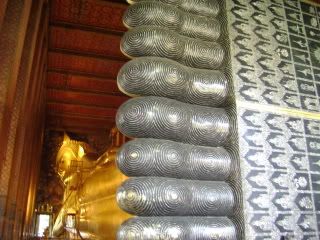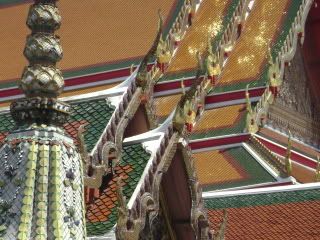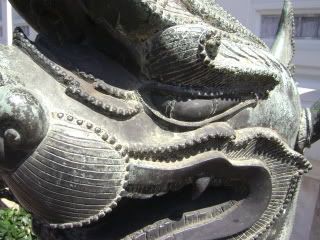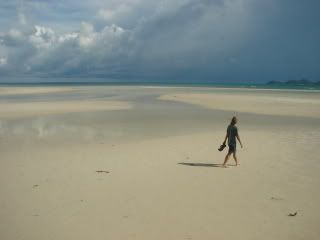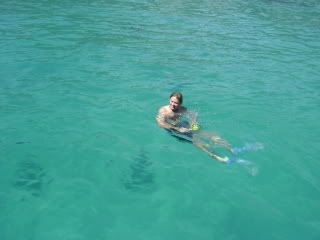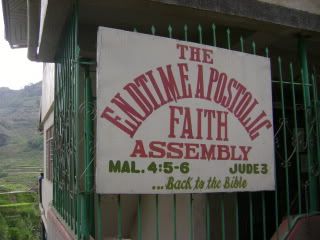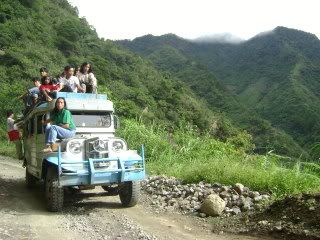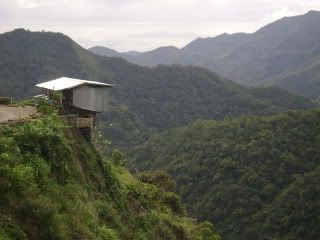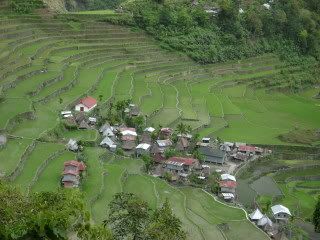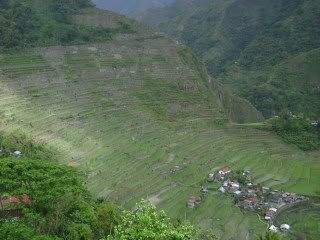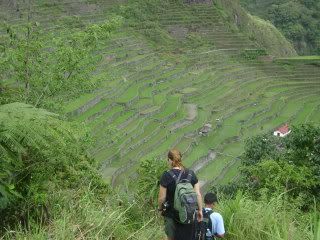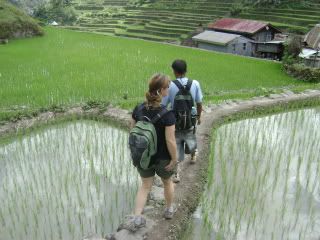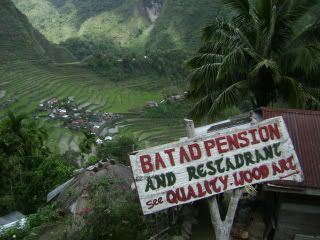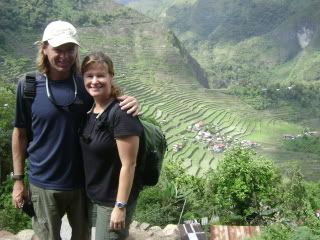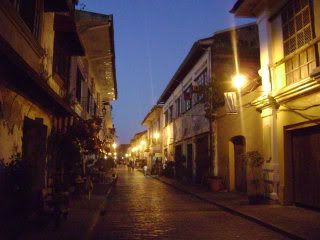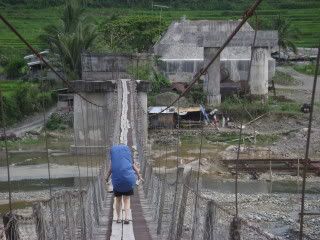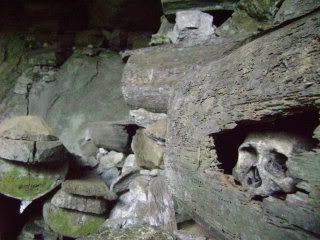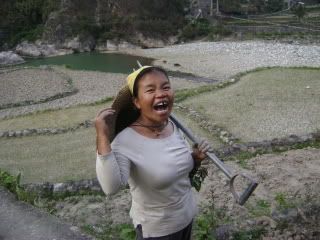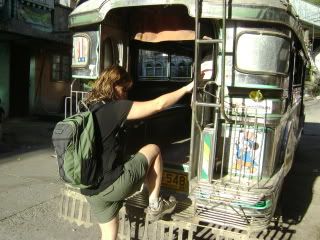C'MON KIDS, IT'S VOMIT TIME
There are some things you see and experience while traveling which will foverever remain complete mysteries. One of those is peoples' propensity toward vomiting.
It's an all-too-common scene while bussing and boating around the third world (and even the second and first). Laura thinks it's because many locals just don't spend that much time on busses or boats and tend to get carsick and seasick quite easily. I don't know what causes it, but I can tell you what happens: Outside of the U.S. and Europe, almost any where you go, as soon as the bus pulls away from the station, or the boat from port, people start to throw up. Who? Men, women, children, the young and old, the healthy and weak -- in short, anyone with a gastrointestinal system.
(Lambir Hills)

On our last trip around the world, in 2002-03, we experienced some spectacular displays of technicolor vomiting. One of the most sustained and intense was on a boat crossing rough waters between the South Island of New Zealand and an offshore island called Stewart. One of the most memorable was on a bus ride across the Atlas Mountains in Morocco. It was summer, it was hot. The locals refused to let anyone open the windows, except to hurl out of them. One woman in the seat in front of us actually held her toddler out fo the window while the kid puked, and then put herself half out of the window while she puked.
This trip has seen no shortage of eruptive vomiting, either. One great time was on a bus across the Andes in Peru. It was night, so it was hard to see the action, but you could hear it clear enough, all right. We actually held our carryon bags in our laps for fear that vomit was sloshing up and down the aisle. Another was in Ecudaor. They had bags in all the seats when you got on the bus. I thought it was for trash. It was for vomit. The bags filled up pretty quickly. And then, it being Ecuador, everyone rolled down their windows and threw the bags out onto the highway shoulder.
(Lambir Hills)

But just yesterday we had the most vivid vomiting to date. We took a small speedboat from Bandar Seri Bagawam, the capital of Brunei, to an island called Pulau Labuan, just off the north Borneo coast in Malaysia. That was not a big deal, but when we boarded a slightly larger boat to head to mainland Borneo, and headed across topsy turvey South China Seas, the action got rolling.
I was sitting next to Laura on the bottom level of the front of the boat. The sun was coming in the window and pounding Laura, so I moved to an open seat across the aisle so Laura could move where I was sitting, into the shade. My new seatmate was a nice young woman who offered me something to eat once I got settled -- it looked like some sort of beancurd donut which is popular with the locals down here.
When the boat pulled out of the harbor and into open ocean the swells started to get pretty big. It doesn't bother me that much but you could tell some people did not like it. Then this young kid who was working as a sort of steward on our level came around saying "Plastic? Plastic?" He was holding up small black plastic bags, which are used either for trash or to vomit into. He held some in front of me. "Oh no," I started to say. "I don't need any" but just then he reached across me and the girl next to me took a fistfull. Then she grabbed another fistfull and said something to the boy, who came back with a trash can and set it between her and me. I started to say, "Oh no, we are fu--" when the girl put her face into the bag and began a sort of screaming vomit. For the remainder of the boat ride -- almost two hours -- she unloaded an incredible amount of vomit into those plastic bags. She would fill one up and drop it in the trash can, and I would hand her some toilet paper, and she would wipe her mouth, and then I'd hand her a fresh bag, and she'd commence to fill it up. It was really pretty incredible. I've never seen anyone puke that much before.
(Miri)

Meanwhile, Laura had her own problems -- though her immediate area remained puke-free. The guy in front of her reclined his broken seat as far as it would go -- nearly horizontal, which meant he was practically laying in her lap -- and stretched his bare feet on to the wall in front of him, and proceeded for the entire boat ride to do this sort of unrelenting tuberculosis projectile coughing. Meanwhile, the boat steward kept on putting these scratched pirated DVDs into the onboard entertainment system, and it was all these ultraviolent movies, and somehow, through all of this, the guy behind her managed to fall asleep and do this enormous chunky moist snore until right before we pulled into Kota Kinabalu. Laura, who is bothered by these things more than I am, said when she got off the boat, "I've lost my edge. I can't handle that any more."
What a boat ride.
TEXAS CHAINSAW DEATH CAGE MATCH -- MOLVANIA: A LAND UNTOUCHED BY MODERN DENTISTRY
VS.
LONELY PLANET'S SOUTHEAST ASIA ON A SHOESTRING
Mostly on this book we've limited our reading to Nobel and Pulitzer prize winners, but we both deviated from this just once and have just finished "Molvania: A Land Untouched By Modern Dentistry."
This is a new guidebook to Molvania, a small country most people did not know existed. It's sandwiched between Slovakia, Poland and Germany and, we learned, is the home of whooping cough and is Europe's leading beetroot producer. It's national dog is the lovable Molvanian Sneezing Hound.
This travel guide gives you insightful tips on seeing the country and enjoying its many sights. It starts out right away with good information.
"Despite being one of the smallest countries in Europe, Molvania has much to offer. Panoramic scenery, magnificent neoclassical architecture and centuries of devotion to fine culture are, admittedly, all in short supply. But the intrepid traveler will still find plenty to enjoy ... like in the south, where visitors can share a glass of locally brewed garlic brandy while watching a traditionally dressed peasant laborer beat his mule."
(Bandar Seri Begawam, Brunei)
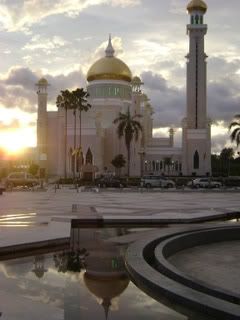
It has helpful information on the local currency. To wit: there are a lot of counterfeit dollar bills out there. Look for the ones with smudged ink and misspelled words as these are most likely to be authentic.
And then there's good info on using pbones. The country code is 372. Numbers for the capital, Lutenblag, having seven digits do not require an additional area code. Six-digit numbers require the area code 2. Eight-digit numbers beginning with 09 generally involve pre-recoded messages of a largely sexual nature.
Naturally, the traveler will want to know where in Molvania to stay. This guide tells you about all the best hotels, like the Rojal Palatz Hotjl "which, as its name suggests, is built directly opposite a particle board factory ... Prices are understandably high, although you will save by booking a room during the winter off-season when the hotel is closed."
Also in Luteblbalg is the famous Revolving Restaurant, though "due to intermittent power supply the restuarant does tend to revolve rather slowly (a full rotation can take up to six months)."
(BSB, Brunei)
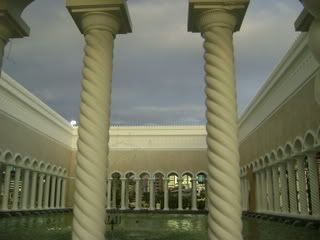
The upcountry town of Sjerezo "has a well developed transport sytem involving trams, trolley buses, trains and light rail. Due to a beaurocratic oversight, however, these various modes of public transports all cover the same short section of road."
Headed to beautiful Lake Vjaza? "For a road crossing a flat plain, the main highway features a suprising number of tight curves and hair-pin bends, a result of having been designed by undergraduate engineering students. If you don't have a car remember that buses leave Lutenblag twice weekly and are towed back at the end of each month."
If you like this info in this book, you might want to check out the other offerings by this guide book company -- Let's Go Bongoswango and Survival Guide to Moustaschistan.
Ah, OK. Molvania does not actually exist, but the guide to Molvania is real -- only it's fiction. The fictional guidebook is brilliant, and seems to have been done both as cheeky entertainment and to take a stab at Lonely Planet.
Lonely Planet. I've travelled to something like 70 countries now, and have taken a Lonely Planet with me to almost all of them. It's a pretty incredible guide book service. They do two things very well: they focus on providing information to low budget travlers and they give detailled information on how to do complicated travel independently.
There are oodles of guidebooks out there, but it seems like most of them cover the same dozen or so countries people have always gone to and will always go to -- Austria, France, Japan, Singapore, New Zealand. Lonely Planet does all those and more. I think they have literally published travel information on every country in the world, and done so with detailled accuracy. I mean, I don't think Brandt has done a travel guide to Honduras. Lonely Planet has and you can find hotels in obscure cities and learn how to catch the bus to even more obscure cities.
For all its brilliant writing, Lonely Planet does two things wrong, and I think they do them wrong on purpose.
First of all, they get prices wrong all the time. Now, figuring costs is difficult. Many countries they cover have ridiculous inflation rates. And many currencies rise and fall and not just in correlation to major currenties, which may rise and fall independently (like the dollar). Also, due to the time it takes to research, publish and sell a guide, the info in a brand new book may still be two years old by the time you get it. But so many prices are so far off base that I have begun to suspect that Lonely Planet purposefully underestimates prices in order to make their books more appealing to the bulk of its customer base -- shoestring travelers.
The second thing Lonely Planet does is talk up a region's beauties while ignoring its uglies, because no one wants to go somewhere someone else is calling ugly. This is more irritating, perhaps, that price deflation. Time and time again Lonely Planet wil wax on and on about a city's charms only for us to arrive and find that those charms are buried under mounds of smoking trash, or obscured by a thick haze of pollution, or hidden by aggressive touts. In some cases, the oblivion to a city's ugliness borders on insane.
And so here I am with my latest Lonely Planet purchase: Southeast Asia on a Shoestring. This book is the company's flagship guide and was the first guide that Lonely Planet ever put out. Now in its 14th edition, it is almost 1000 pages long.
In it is an incredible amount of detailed information. I can find exactly how to catch a local bus to the long distance bus terminal, and know which end of town to stay on to be close to restaurants and museums. I know where restaurants are, when museums open, and which borders have crooked officials. This sort of information given to such diverse countries has, I believe, actually changed tourism worldwide and made the previously inaccessible now very accessible.
And yet, the more I read the more I think of Molvania. Does fiction imitate nonfiction? Or is it the other way around? Molvania is funny because it imitates reality. Lonely Planet is not funny because it often ignores it. Here are some Lonely Planet entries in our guide. You decide:
"The rooms aren't as appealing as the exterior and are mostly the standard, windowless variety."
"One of the town's better options, the New Caspian is run by a nice couple and rooms have TV and mould-free bathroms. Don't confuse it with its less appealing namesake on Jubilee Street."
"Our pick!" 100 Cintra Street -- Housed in a sometimes operating museum in a semi-restored mansion, this is by far Penang's most atmospheric budget option. You get a very thin mattress on a wooden platform with a fan and a mosquito net for that Eastern colonial experience. Dorm beds are on an open landing and have absolutely no privacy."
"These large bungalows were under renovation at the time of writing but even the old ones look good. Little English is spoeken, half naked kids run around the garden with a few stray chickens and rice is served for breakfast."
"Floors give way underfoot and the beds are lumpy but the place is spotless."
"Ths in-room cable TV is nice, as long as you're happy watching the same programme as the hotel staff in the lobby."
